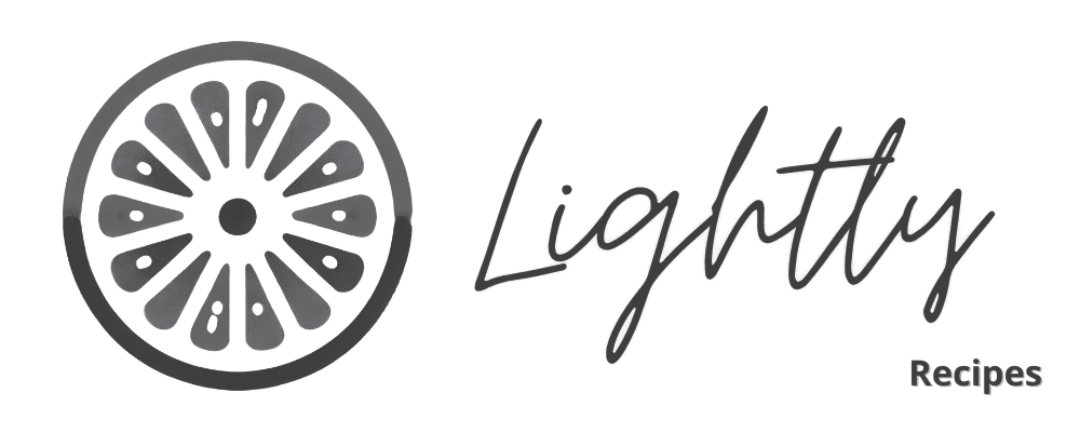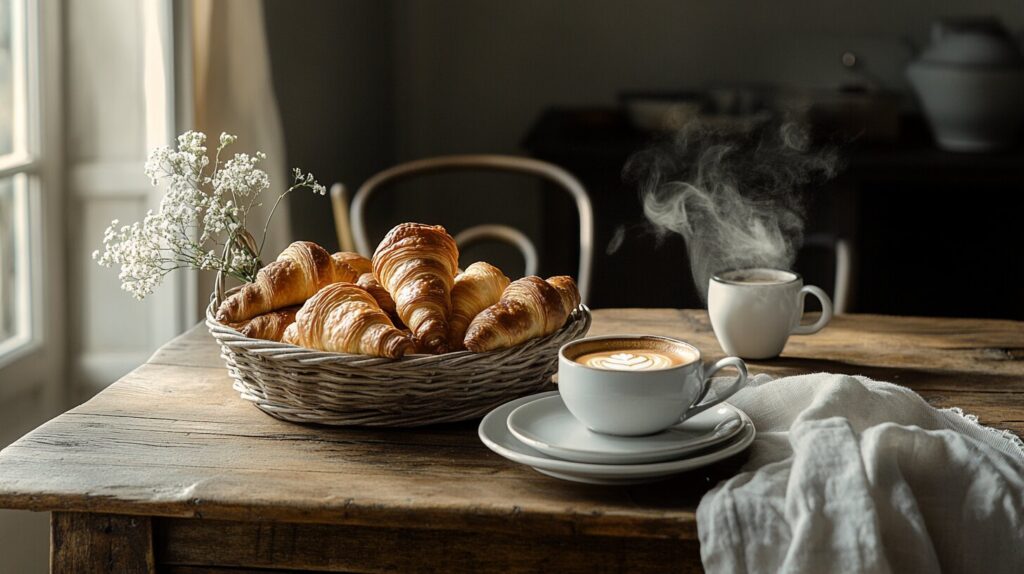
French pastry recipes are the pinnacle of baking elegance. From buttery, flaky croissants to colorful, delicate macarons, these French pastry recipes embody craftsmanship, precision, and a touch of magic. If you’ve ever wondered how to create these delightful treats at home, you’re in the right place! This guide will walk you through everything — essential tools, classic recipes, troubleshooting common problems, and more. So, are you ready to whip up some French baking magic? Let’s dive in!
Table of Contents
Introduction to Mastering French Pastry Recipes
French pastries have enchanted people for centuries. Whether it’s the satisfying crunch of a perfectly baked croissant or the smooth, creamy filling of an éclair, French baking is a celebration of texture and flavor. But while they may seem intimidating, making these pastries at home is absolutely doable with the right guidance.
French pastries are rooted in tradition, yet they continue to evolve. They are more than just desserts; they’re art forms, each bite telling a story of technique and passion.
So, how do you go from being a curious baker to a French pastry aficionado? Well, it all starts with understanding the basics, and this guide has your back! 🙌
Essential Ingredients for Authentic French Pastries
French pastries boast a legacy as rich as their buttery layers. But how did they become the culinary icons they are today?
The Origins of French Pastries
The roots of French pastry recipes go back to the Middle Ages, when baking evolved from basic bread to more sophisticated baked goods. During the Renaissance, French culinary skills flourished under the influence of Catherine de Medici, who brought Italian chefs and pastry expertise to France when she married King Henry II.
Over time, these influences shaped what we now know as classic French pastry. By the 17th and 18th centuries, French bakers began crafting what we recognize as pâtisserie. Notably, pastry chefs like Marie-Antoine Carême elevated pastry-making to an art form, introducing elaborate designs and refining techniques.
Pastries and Paris: A Love Story
Paris quickly became the epicenter of pastry innovation. As patisseries popped up across the city, they offered everything from buttery viennoiseries (like croissants and pains au chocolat) to delicate pâtisseries (such as tarts, éclairs, and macarons). Even today, the French celebrate pastries with festivals and competitions, honoring the dedication behind each creation.
A Global Influence
Over the years, French pastry techniques have traveled far and wide, inspiring bakeries across the globe. For instance, chefs in Japan, the U.S., and beyond have embraced and reinvented French pastries, adding local twists and flavors. 🌎
“French pastry is not just about baking; it’s about storytelling, culture, and the relentless pursuit of perfection.” — Every Pastry Chef Ever
Essential Ingredients for Authentic French Pastries
If you want to bake authentic French pastries, quality ingredients are key. French baking relies on simple yet high-quality staples. Here’s a breakdown of what you’ll need:
Butter 🧈
French pastries are all about butter. The butter you choose can make or break your recipe. Therefore, opt for European-style butter, which has a higher fat content (82% or more). This results in flakier croissants and a richer flavor.
Pro Tip: Look for unsalted, high-fat butter. In France, “Beurre d’Isigny” or “Beurre Charentes-Poitou” are gold standards.
Flour
When it comes to flour, pastry flour or all-purpose flour works best for most French pastries. However, for breadier pastries like croissants, a high-protein bread flour is your go-to option.
Eggs 🥚
Eggs provide structure and richness to many recipes. Be sure to use fresh, large eggs for the best results. Additionally, many French pastry recipes call for just the yolks, especially for creams and fillings.
Sugar
Granulated sugar is commonly used, but for some delicate pastries (like macarons), powdered sugar is essential.
Yeast
For laminated pastries like croissants, fresh or instant yeast helps achieve the perfect rise. Be sure to activate it properly for the best results.
Chocolate 🍫
When making pain au chocolat or éclairs, quality chocolate matters. Therefore, go for dark, high-cocoa-content chocolate for an authentic taste.
Vanilla
Whether using vanilla beans, extract, or paste, this ingredient is the soul of many French pastries. Always use high-quality vanilla for the best flavor.
Cream
Heavy cream or double cream is essential for making ganaches, mousses, and fillings. When possible, choose a cream with a high fat content for richer results.
Must-Have Tools for French Pastry Baking
Let’s talk tools! French pastry recipes require a few essential gadgets. These aren’t just for show; they make your baking more precise and enjoyable. So, before you get started, make sure you have the following:
Rolling Pin
A sturdy, straight rolling pin helps achieve uniform layers for laminated dough. Forget the ones with handles; a French rolling pin is your new best friend.
Pastry Brush
For egg washes and glazes, a good pastry brush is a must. Silicone brushes are easy to clean, but natural bristle brushes offer greater precision.
Digital Scale
Precision matters in French pastry. Therefore, weighing ingredients is far more accurate than using measuring cups.
Piping Bags and Tips
For éclairs, macarons, and decorations, a piping bag is essential. It’s a good idea to stock up on various tips (round, star, etc.) for different effects.
Bench Scraper
This handy tool is perfect for cutting dough and cleaning surfaces. It also helps maintain clean, even cuts when working with laminated dough.
Baking Mats or Parchment Paper
Non-stick silicone mats help ensure even baking, especially for delicate pastries. On the other hand, parchment paper works just as well if silicone mats aren’t available.
Classic French Pastry Recipes You Need to Try
Now, the fun part — the recipes! Let’s explore some classic French pastries that you can try at home. Don’t worry; we’ll break them down step by step so you can master each one. By the time you’re done, you’ll feel like you’ve brought a slice of Paris into your kitchen. So, let’s get baking!
The Perfect Croissant French Pastry Recipe 🥐
Croissants are the crowning glory of French pastries. Flaky, buttery, and crisp — these iconic treats are worth the effort. While making croissants might seem daunting, following a few key steps can help you achieve bakery-level results.
Ingredients:
- 500g bread flour
- 300g cold butter (for laminating)
- 10g salt
- 50g sugar
- 10g instant yeast
- 250ml cold milk
- 1 egg (for egg wash)
Steps:
- Make the Dough:
First, mix the flour, sugar, yeast, salt, and milk in a large bowl. Knead the mixture until you get a smooth dough. Then, let it chill in the refrigerator for at least 1 hour. Chilling is crucial because it firms up the dough, making it easier to work with later. - Laminate the Butter:
Next, roll out the dough into a rectangle. Place the cold butter in the center and fold the dough over it, completely sealing the butter inside. Roll it out gently and fold it like a letter. Repeat this step 3-4 times, chilling the dough between each fold. This process creates those beautiful, buttery layers. - Shape the Croissants:
Once the dough is laminated, roll it out into a large sheet. Cut the dough into triangles, then roll each triangle from the base to the tip to form the classic crescent shape. - Proof and Bake:
After shaping, let the croissants proof (rise) for 1-2 hours until they’re puffy. Brush them with an egg wash to give them a golden sheen. Finally, bake them at 190°C (375°F) until they’re beautifully golden and flaky.
“A croissant is more than a pastry; it’s a morning ritual wrapped in layers of buttery goodness.”
How to Make Flaky Pain au Chocolat French Pastry Recipe 🍫
Pain au chocolat, often called a chocolate croissant, is another classic that never fails to delight. Essentially, it’s the same dough as croissants but with a delicious chocolate filling.
Ingredients:
- Use the same dough recipe as the croissants
- 2 chocolate batons or high-quality dark chocolate bars
- 1 egg (for egg wash)
Steps:
- Cut the Dough:
First, roll out the laminated dough into a large rectangle. Then, cut the dough into smaller rectangles — about 3 inches by 6 inches. - Add Chocolate:
Place a chocolate baton or two strips of dark chocolate on the shorter end of each rectangle. Roll the dough tightly over the chocolate to encase it. - Proof and Bake:
Let the rolls proof for 1-2 hours until they puff up. Brush with egg wash, then bake at 190°C (375°F) for 15-20 minutes, or until golden and flaky. - Enjoy:
Once baked, let them cool slightly. Then, take a bite and enjoy the satisfying mix of crisp pastry and melty chocolate.
Traditional French Éclair Pastry Recipe 💫
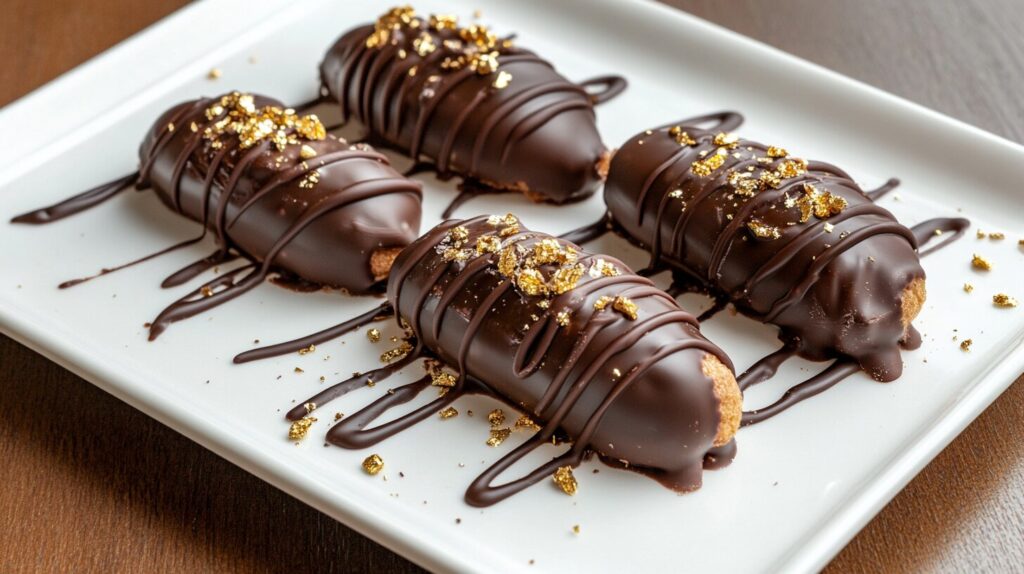
Éclairs are elegant choux pastries filled with luscious cream and topped with a glossy chocolate glaze. While they look fancy, they’re surprisingly achievable at home.
Ingredients:
- 125ml water
- 125ml milk
- 100g butter
- 150g flour
- 4 large eggs
- 500g pastry cream
- Dark chocolate and cream for the glaze
Steps:
- Make the Choux Dough:
In a pot, bring the water, milk, butter, and a pinch of salt to a boil. Once it boils, add the flour all at once and stir vigorously until the dough forms a ball and pulls away from the sides. Let it cool slightly. - Add the Eggs:
Gradually beat in the eggs one at a time until the dough is smooth and glossy. - Pipe and Bake:
Pipe the dough into 5-inch long strips onto a baking sheet. Bake at 200°C (400°F) for 20-25 minutes, until puffed and golden. - Fill and Glaze:
Fill each éclair with pastry cream using a piping bag. Dip the tops in melted chocolate glaze and let them set.
Delicate Macarons: A Classic French Pastry Recipe 🌈
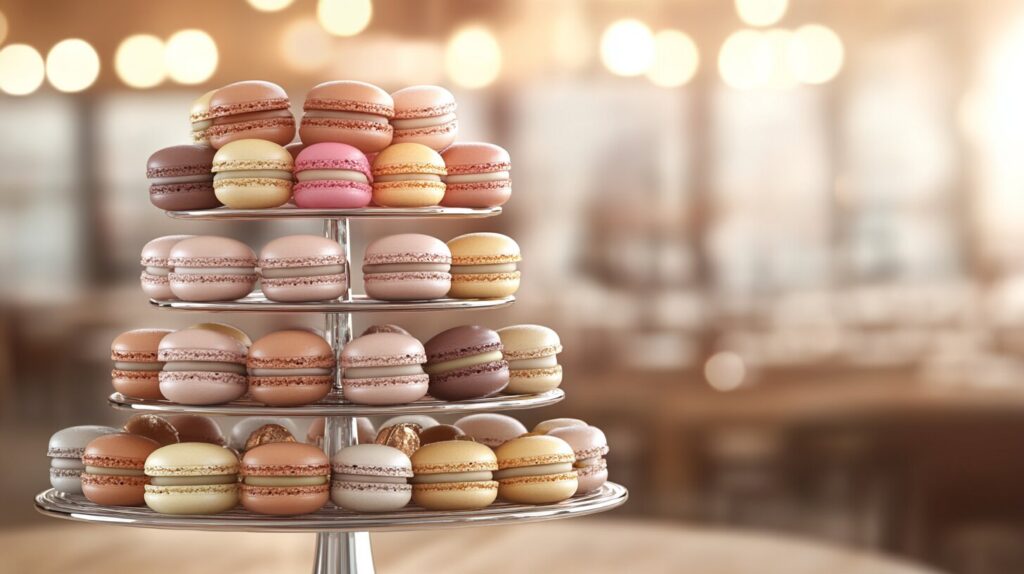
Macarons are colorful, delicate, and irresistibly delicious. While they’re known for being finicky, a few tricks can help you achieve the perfect result.
Ingredients:
- 100g almond flour
- 100g powdered sugar
- 100g granulated sugar
- 2 large egg whites
- Food coloring (optional)
- Your favorite filling (ganache, buttercream, or jam)
Steps:
- Sift and Mix:
First, sift the almond flour and powdered sugar together to remove any lumps. This ensures smooth shells. - Make the Meringue:
Next, whip the egg whites with granulated sugar until you have stiff, glossy peaks. Add food coloring if desired. - Macaronage:
Carefully fold the almond flour mixture into the meringue. The batter should flow like lava — thick but still pourable. - Pipe and Rest:
Pipe the batter into small circles on a baking sheet lined with parchment paper. Let them rest for 30 minutes until a skin forms on the surface. - Bake and Fill:
Bake at 150°C (300°F) for 15 minutes. Once cooled, sandwich two shells together with your chosen filling.
Advanced Techniques for Perfecting French Pastry Recipes
Now that you’ve mastered the basics, it’s time to level up with some advanced techniques. These skills will not only refine your pastries but also impress anyone lucky enough to taste them.
Laminating Dough for Flawless French Pastry Recipes
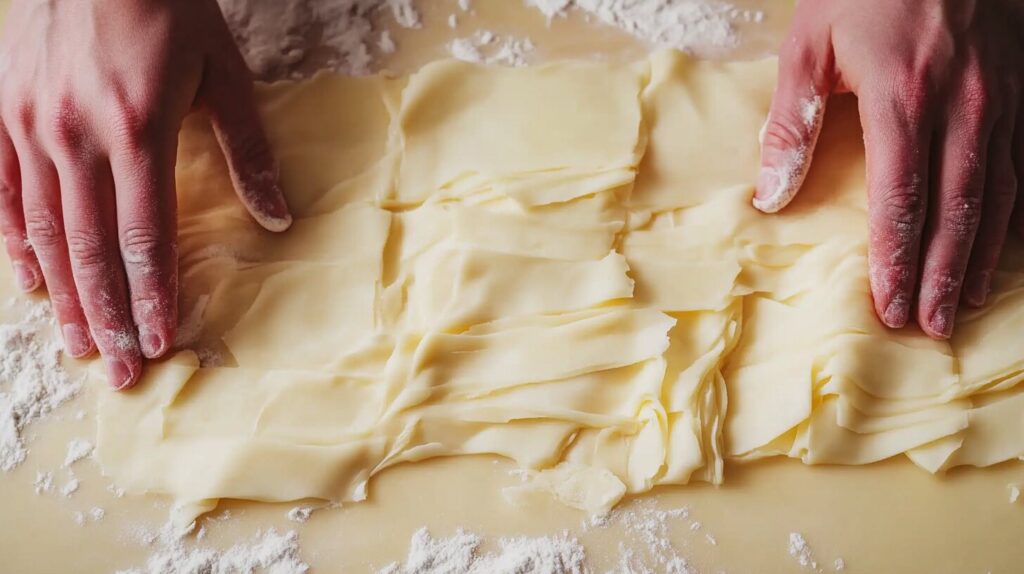
Laminating dough is the process of layering butter into the dough to create those signature flaky layers in pastries like croissants. Here are some tips to master it:
- Keep Everything Cold: Cold butter and dough are essential. If they get too warm, the butter will melt into the dough, ruining the layers.
- Be Precise with Folds: Make sure each fold is even and the edges are straight. This ensures uniform layers.
- Rest Between Folds: Chilling the dough between folds allows the gluten to relax, making it easier to roll out.
Perfecting Pâte à Choux for French Pastry Recipes
Pâte à choux is the versatile dough behind éclairs, cream puffs, and profiteroles. For perfect choux pastry:
- Dry Out the Dough: When cooking the flour mixture, stir it until it forms a cohesive ball and dries out slightly.
- Add Eggs Gradually: Add one egg at a time, making sure each one is fully incorporated.
- Bake with Steam: Introduce steam into your oven by placing a tray of water at the bottom. This helps the pastry puff up beautifully.
French Pastry Presentation and Plating Ideas
Presentation is the final flourish that turns a delicious French pastry into a memorable culinary experience. The French are known for their attention to detail, and this extends to how they present their pastries. After all, we eat with our eyes first! If you’ve gone through the effort of baking these treats, it’s worth taking a little extra time to make them look as beautiful as they taste.
Embrace Minimalism for Elegance
French pastry presentation is often about simplicity and refinement. You don’t need elaborate decorations to make a pastry look appealing. For instance:
- Dust with Powdered Sugar: A light sprinkle of powdered sugar on croissants or tarts adds an elegant touch.
- Drizzle with Chocolate: For éclairs or pain au chocolat, a fine drizzle of dark chocolate can make them look even more enticing.
- Garnish with Fresh Herbs: A tiny sprig of mint or basil can elevate a fruit tart or a cream-filled pastry.
Use Plates and Stands to Your Advantage
Your choice of serving ware matters. Consider these options for various pastries:
- Macarons: Display them on a tiered stand for a sophisticated look, perfect for afternoon tea or special occasions.
- Éclairs: Serve on a long, rectangular plate to highlight their shape and make them look sleek and modern.
- Tarts: A simple white plate allows the colors of your fruit or cream to pop.
Incorporate Colorful Elements
French pastries often have neutral tones — browns, creams, and whites. Adding pops of color can make your presentation more vibrant:
- Fresh Berries: Place raspberries, blueberries, or strawberries beside your pastries for a burst of color and flavor.
- Edible Flowers: Decorate tarts, cakes, or even macarons with edible flowers like violets, pansies, or lavender for a touch of whimsy.
- Fruit Coulis: A bright fruit sauce can be artfully drizzled on the plate for a restaurant-quality finish.
Exploring Regional Variations of French Pastry Recipes
France is a country with diverse culinary traditions, and each region boasts its own iconic pastries. Exploring these regional specialties is like taking a delicious tour of France. Let’s look at some must-try pastries from different areas.
Brittany: Kouign-Amann
Originating from Brittany, Kouign-Amann is a caramelized, buttery pastry made from laminated dough. It’s like a croissant but with a sugary, crispy exterior. The name translates to “butter cake” in Breton, and it lives up to that promise!
Alsace: Kugelhopf
From Alsace, Kugelhopf is a yeasted cake baked in a distinctive fluted mold. It’s usually studded with raisins and sometimes flavored with brandy. It’s the perfect combination of bread and cake, often enjoyed at breakfast or as an afternoon treat.
Provence: Navettes
In Provence, Navettes are boat-shaped cookies flavored with orange blossom water. These simple, crisp cookies are often associated with the celebration of Candlemas and are a beloved local tradition.
Paris: Macarons and Éclairs
Of course, Paris is the capital of French pastry, famous for its delicate macarons and glossy éclairs. Many of the world’s best pastry chefs hone their craft in the City of Light, creating innovative takes on these classics.
Normandy: Tarte Tatin
From Normandy comes the Tarte Tatin, a caramelized upside-down apple tart. Legend has it this pastry was created by accident, but it has become one of France’s most iconic desserts.
French Pastry Recipes Perfect for Special Occasions
French pastries are perfect for making any occasion feel special. Whether you’re hosting a dinner party, celebrating a holiday, or planning a wedding, there’s a French pastry to match the mood. Here are some ideas for different events.
Festive Pastries for Holidays
French pastries add a touch of magic to holiday celebrations. Consider these for your next festive gathering:
- Bûche de Noël: This Yule log cake is a Christmas tradition in France. Made from a sponge cake rolled with buttercream and decorated to look like a log, it’s as beautiful as it is delicious.
- Galette des Rois: Celebrated during Epiphany, this puff pastry filled with almond cream comes with a hidden fève (trinket). Whoever finds the fève becomes the king or queen for the day!
- Croquembouche: A towering cone of cream puffs held together with caramel, the Croquembouche is a show-stopping centerpiece for weddings and special events.
Elegant Pastries for Weddings and Events
French pastries can bring sophistication to any wedding or formal gathering:
- Macaron Towers: Instead of a traditional wedding cake, consider a macaron tower in the couple’s favorite colors. It’s elegant, modern, and delicious.
- Mini Éclairs: Offer a variety of mini éclairs with different fillings — vanilla, chocolate, coffee, or pistachio — for a bite-sized treat that guests will love.
- Choux Pastry Swans: These delicate swans made from pâte à choux are filled with whipped cream and look stunning on a dessert table.
Conclusion: Enjoy the Art of French Pastry
Mastering French pastry recipes is a journey of patience, precision, and passion. While some recipes may seem intimidating, the joy of biting into a homemade croissant or perfectly crisp macaron makes it all worthwhile. Remember, baking is as much about the process as it is about the final product. So take your time, enjoy each step, and don’t be afraid to make mistakes — because even the pros started somewhere.
Whether you’re baking for yourself, your family, or a special event, these pastries are sure to bring joy and satisfaction. Now, go forth and create your own little corner of Paris in your kitchen! Bon appétit! 🥖✨
FAQs About French Pastry Recipes
How long does it take to make croissants?
Croissants take time due to the lamination process. From start to finish, it typically takes about 12-24 hours, including resting periods. The effort is worth it for those flaky, buttery layers!
Can I make French pastries without special equipment?
Yes! While tools like a rolling pin, pastry brush, and piping bags are helpful, you can still make many pastries using basic kitchen tools. Precision and patience matter more than fancy gadgets.
How do I keep macarons from sticking to the baking sheet?
Make sure to use parchment paper or a silicone baking mat. Let the macarons cool completely before attempting to remove them. They should peel off easily when fully baked.
Why did my pâte à choux collapse?
If your choux pastry collapses, it’s usually due to underbaking. Ensure they are golden brown and firm to the touch before taking them out of the oven. Avoid opening the oven door during baking, as sudden temperature changes can cause them to deflate.
Can I freeze French pastries?
Absolutely! Many French pastries, like croissants, pain au chocolat, and macarons, freeze well. Wrap them tightly in plastic wrap and store them in an airtight container for up to 2 months. Reheat or thaw before serving.
What is the difference between a macaron and a macaroon?
A macaron is a delicate French pastry made from almond flour, meringue, and filling, while a macaroon is a dense, chewy coconut-based cookie. They are entirely different treats!
Explore More Delicious Recipes and Guides 🍰
If you enjoyed mastering French pastry recipes, you’ll love discovering more delicious treats and helpful guides on our site! Want to dive into easy and healthy snacks? Check out our Rice Cakes: Benefits and Recipes for Healthy Snacking. For something sweet and comforting, try our recipe for Cinnamon Sugar Muffins. Curious about gluten-free options? Don’t miss our Matcha Muffin Recipe with Almond Flour.
Happy baking and exploring! ✨
